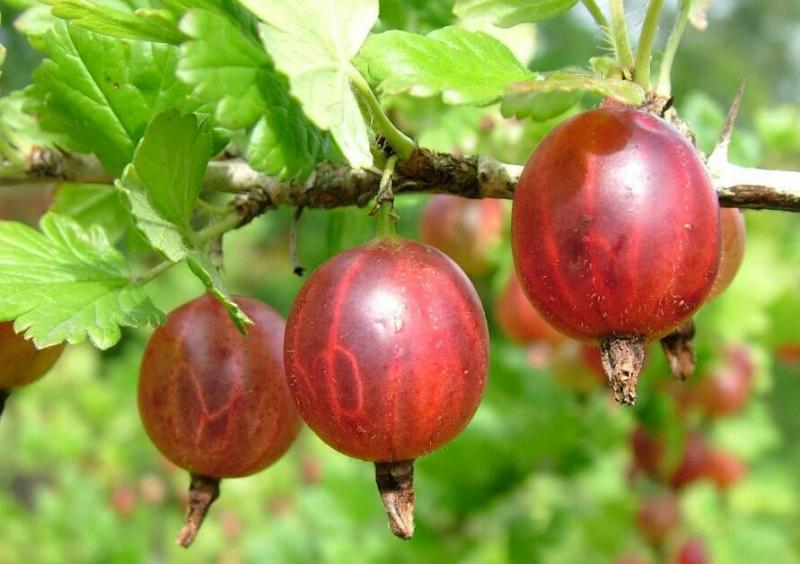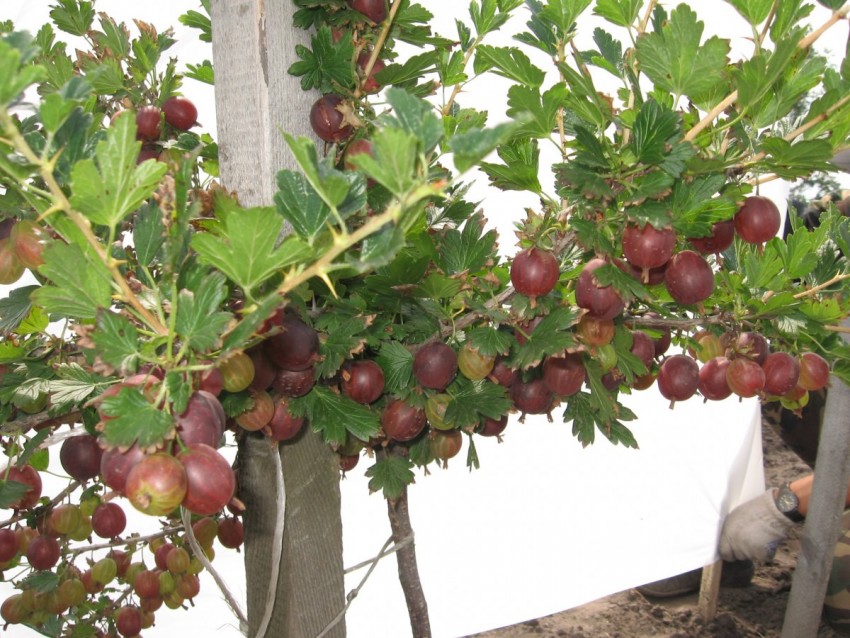Thornless gooseberry Senator with high yield and excellent taste
The besshorny gooseberry Senator is loved by many summer residents for its positive qualities. It bears fruit for a long time, is resistant to powdery mildew, gives a rich harvest of delicious berries. Its ability to withstand low and high temperatures allows it to be grown universally.
The content of the article
What is this gooseberry variety
The bush is vigorous, the crown is dense, medium-sized. The branches are straight, green, of medium thickness. Closer to the root, there are curved shoots of a brown shade.
History of origin and distribution
The second name of the gooseberry is Consul. The variety is young. It was taken out in the South Ural Research Institute of Fruit and Vegetable and Potato Growing. VS Ilyin crossed the Chelyabinsk Green and African varieties. The resulting Senator turned out to be practically thornless, with good frost and drought resistance. In 1995, the plant was included in the State Register of Russia.
Characteristics and description of the bushes
The variety is of medium ripening. A bush with a large number of branches reaches a height of 1-1.5 m, a diameter of 2-3 m. Young branches are straight, green, without pubescence. Thorns are absent or small. The shoots are flexible and straight, slightly bent at the time of harvesting.
The leaves are small, shiny. They have blunt teeth with clear veins. The shape is in the form of 5 lobes of dark or light green color. Petioles with 3-4 leaves and 1 ovary grow on shoots. Flowers of the male and female types are collected in inflorescences of 2-3 - gooseberry pollination is not required.
Resistant to temperatures
Low temperature tolerance is determined by the cultivation area. In the southern regions, the shrub can withstand frosts down to -25… -30 ° C. The northern climate is characterized by dry winter air and temperatures of -28… -35 ° C.
Reference. In regions with cold winters, the shrub needs shelter with leaves and hay.
Wintering in damp frosts at -25 ... -35 ° C leads to diseases, lack of harvest or death of gooseberries.
Moisture and drought resistance
The bush can withstand heat at + 30 ... + 35 ° C, but the fruits dry out or baked in the open sun. Favorable climate for growing thornless gooseberries Senator is moderate.
The variety does not tolerate drought well, so the soil must be constantly moderately moistened.
Disease and pest resistance
The senator is resistant to damage by powdery mildew, but it is not protected from attacks by sawflies, root cancer, fruit gray rot or septoria and needs preventive measures.
Early spring the bushes are sprayed with insecticides, fed with phosphates. As feeding use phosphate rock at the rate of 2.5-3 tbsp. l / m² or double superphosphate at a dosage of 2–2.5 tbsp. l. / m². The most popular insecticides are Actellik CE (10 ml per 10 l of water) or Bitoxibacillin P (100 g per 10 l of water).
Characteristics and description of fruits

The berries are red or dark pink, round, practically without seeds. Green streaks are clearly visible on the surface. The taste is sweet and sour, the aroma is delicate. Tasting score - 4.7 points. The fruits contain 6.7% sugars, 3.1% acids, 25.7 mg% ascorbic acid. Thin skin does not crack when ripe due to its high strength.
The mass of one berry is 3-4 g.Up to 4 kg of harvest is harvested from young bushes. With an increase in the number of shoots, the yield also increases - up to 7-8 kg of berries are harvested from an adult Senator gooseberry per season.
Application area
Senator gooseberries are used in winter harvesting. They are prepared from:
- jams;
- jam;
- juices;
- jam.
In the production of ice cream, desserts, yoghurts, gooseberry pulp is well suited.
Application in cosmetology:
- hair growth is promoted by rinsing in a decoction of gooseberry leaves;
- to remove age spots, juice and fruit pulp are added to the composition of creams and masks;
- gooseberry seed oil is applied to the hair roots to prevent gray hair.
Freshly squeezed gooseberry juice normalizes metabolism, strengthens the cardiovascular system. The fruits have tonic and anti-inflammatory properties.
Advantages and disadvantages of the variety
The main advantages of the Senator:
- high productivity;

- lack of thorns;
- self-pollination;
- frost resistance;
- immunity to powdery mildew;
- long life span (18–20 years);
- great fruit taste.
disadvantages:
- because of the thin peel, the berries are not suitable for transportation;
- the variety does not tolerate wind and drafts;
- the plant needs constantly moist soil, does not tolerate drought.
Growing technology
Despite the unpretentiousness of the bush, its development should not be allowed to flow. With this approach, low yields are noted.
Optimal conditions
For Senator gooseberries, a sunny area with no drafts and protection from the wind is optimal. The soil is needed loose, fertile, rich in humus and nutrients. Groundwater should not touch the roots of the gooseberry in order to exclude waterlogged soil and not cause fungal diseases.
Terms and rules of landing
Spring planting is carried out after the last snow melts. In the fall, gooseberries are planted a month before the onset of frost.
Landing Algorithm:
- The day before the procedure, soak the seedlings in a growth stimulator.
- Maintain a distance of at least 1.5 m between the bushes. The depth of the planting pit is 50-60 cm.
- Cover the bottom with peat or humus. Apply fertilizers: 50 g of potassium salts and superphosphate per 1 pit.
- Remove dead shoots from the seedling, cut the rest by 1/3.
- Spread the roots and plant the plant. Deepen the root collar by no more than 6 cm.
- Fill the remaining space in the pit with soil and tamp.
- Cover the ground with straw, sawdust, pine needles.
- Spill the bush with plenty of water.
Further care
During the adaptation period, it is important:
- Protect the bush from direct sunlight, stagnant water, drafts and strong winds.
- Watering is carried out 3 times per season: during flowering, when fruits are ripe, after harvest.
- Pruning young shoots that have grown over the season should be carried out the next spring, shortening them by 1/3 or 1/4 of their length. Do not cut off the fruiting branches of the past season next year.
- Do not apply fertilizers in the first year of planting. From the second year, use nitrogen mixtures (infusion of manure or nettle) every 2 weeks, until mid-August. When forming buds, add 40 g of superphosphate per 1 bush.
When the first signs of infection of the bush appear, preventive measures are taken.
Possible problems, diseases, pests
Culture resistance to a number pests and diseases does not cancel additional protective measures:
- Spraying with a 1% solution of Bordeaux liquid before flowering and after harvesting helps with columnar rust and anthracnose.
- In the fight against moth and gooseberry aphids, they use Karbofos at the rate of 60 g / 10 l of water, or 1-2 tablets of Inta-Vira per 10 l of water.
- The spider mite is removed with Aktellik. For processing take 2 ml of the drug for 2 liters of liquid.
- From sawflies "Iskra" is good at a dosage of 60 ml per bucket of water, "Aktara" at the rate of 1 ml per 5 liters of water.
- Root cancer is not cured. The diseased plant is dug up and burned, and the soil is disinfected with 2% bleach.
- Fruits affected by gray rot are removed along with the branches.For prophylaxis, they treat bushes from weevils, moths, caterpillars with Iskra or Actellik preparations.
- Septoria is fought with Bordeaux liquid. A bucket of water will require 100 g of the drug. Spray the bush before bud break.
Regular removal of diseased shoots and pests will prevent massive gooseberry infestation.
Wintering
The harvest of the next year directly depends on the success of wintering.
Reference.The frost resistance of the variety makes it possible not to cover the shrub additionally. An exception will be regions where there is a lot of snow.
Work before winter:
- Carry out sanitary pruning of the bush.
- Treat pests, water abundantly, add 200 g of ash to the soil.
- Collect all leaves and debris around the plant.
- Apply fertilizers under the root, for example, a urea solution at a dosage of 1 tbsp. l. for 1 bucket of water or a mixture of 1 kg of ash and 1 kg of humus.
Features of cultivation depending on the region

Unpretentiousness to temperature conditions allows you to grow Senator gooseberries in the Far East, Urals, Siberia and southern regions. The variety is resistant to high temperatures in hot regions and cold winters of the northern regions of the country.
In hot areas, gooseberry protection from high temperatures will be required by creating penumbra (for this, walls are erected on the sunny side). In areas with cold winters, bushes are additionally covered, protecting the roots and shoots from freezing.
Pollinating varieties
Due to the presence of male and female flowers in the Senator, there is no need to attract pollinating varieties. It is a self-pollinated plant landing other varieties nearby will not affect the yield.
Reproduction
Get new gooseberry bushes in 3 ways:
- Layers. For this, a powerful thick branch is pressed to the ground, covered with soil. The earth is kept moist. After a while, roots form on the shoots, shoots appear. They are separated next season.
- Stem petioles. A thick, healthy branch is taken as a mother base and cut into petioles with 4-5 buds. Each is placed in a container with soil, leaving 1 kidney above the ground. Rooted cuttings are planted in open ground in a permanent place.
- By dividing the bush. A large overgrown gooseberry is neatly divided into several new ones, removing old dried branches.
Reviews of summer residents
Gardeners are happy to share their experiences, achievements and failures in growing this variety.
Natalia, St. Petersburg: “I got a Senator sapling from O'Key. At the same time I took another variety, with thorns. I landed in open ground at the end of April. Arriving at the dacha a week later, I noticed that the Senator was frail and sluggish, and did not take root well. Watered the plant fed, treated from pests - it seems to have helped. The bush took root and began to grow. Despite the unpretentiousness of the variety, it did not work to grow by only one planting. Culture requires attention and care to itself unambiguously. "
Elena, Samara: “Senator gooseberries like the taste of the fruit - the berries are much sweeter than other varieties. The plant successfully survives the winter with severe frosts. The children loved this bush because of the lack of thorns. "
Conclusion
Gooseberry Senator has earned attention due to its sweet and sour fruits, the absence of thorns on the shoots, resistance to low temperatures and ease of care. Due to the self-pollination of the variety, it is not required to plant other plants nearby.
It is not always possible to save the culture from the attack of pests and protect it from diseases. Despite its resistance to powdery mildew, the variety is susceptible to insect attack, the appearance of gray fruit rot, root crayfish or septoria. It is important to carry out prophylaxis on time, do not overmoisten the soil and prevent drought, disinfect the soil before planting.